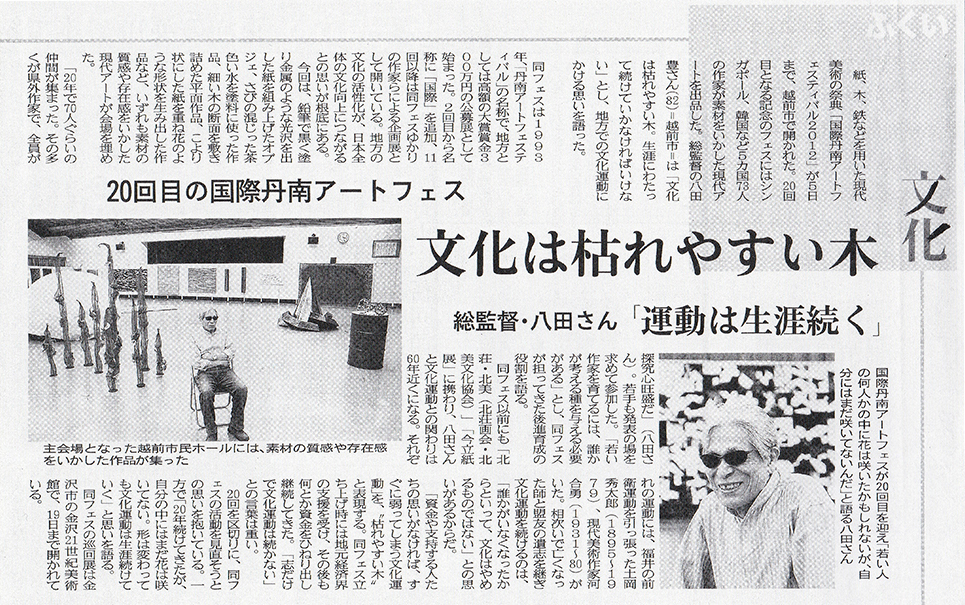In 1990, Hatta, who dropped from the Imadate Paper Exhibition, searched for the next development, placing the stage of the movement in his hometown, Takefu. In the spring of 1992, Kiichiro Tamagawa and other volunteers met and consulted Taniarata, (another note 2) in Tokyo who adjudicated the Imadate Paper Exhibition at that time, and they formed an executive after their return to Takefu. In the next year, 1993, they chose Tamagawa as the first chief of the executive, and held the contemporary art competition "Tannan Art Festival '93" in the Tannan area (the generic name of a wide area including Takefu City and Sabae City).
He sought to create a distinction in the exhibition by enforcing an experiment. He hoped for a new unique expression through using the following five local materials, all related to industries in the Tannan area, as expressive media--iron (Echizen Cutlery as a traditional industry), clay (Echizen Ware as one of Japan's six oldest ceramics), wood (residences descended from father to son in snow area and shrines and Buddist temples professed by people), cloth (the leading textile industry area in Japan), paper (Echizen washi which has a 1,500 year tradition).
Based on the response to the Imadate Paper Exhibition, Tannan Art organized the directorate consisting of enterprisers from the economic world, and set the total prize money at three million yen for the first year. That was much more than that of the Imadate Paper Exhibition competition. In the second, there were many entries from Italy, so "International" was added to the title. In this exhibition, there were special exhibitions, a performance, symposium, workshops, and other events, so it came to be known as an art festival.
In 1996, the "Commemoration of the 100th Anniversary of Hidetaro Tsuchioka's Birth, 100 Pieces' Exhibition" was held in Takefu Citizens' Hall for the 'International Tannan Art Festival '96 Special Exhibition'. In this exhibition, 100 works of 100 artists were gathered in order to match the number of years. They asked not only participants of Hokubi, but also people who were in some way involved Fukui, Imadate Paper Exhibition or Tannan Art. It turned out that quite a diverse line-up assembled, including foreign artists. Ichiro Haryu, an art critic, made a commemoration lecture.
Tannan Art allowed various representations through multiple materials which couldn't be achieved by a single material in the Imadate Paper Exhibition, and it became a nationally rare handmade competition. Works and people from various places gathered in Fukui, and its reputation spread nationally-Okayama, Gunma, Kobe, Osaka, Kochi, etc.. In addition, its reputation also extended abroad to South Korea, Italy, the United States, Israel, Brazil, and Sweden. Hatta continues the original movement through art and human relationships when invited to these places, or inviting others to Fukui.
The sixth in 1998, was a corpus of five years, and it became a planned exhibition. They invited artists who had applied or were invited before, and those who the executives had met in exhibitions both inland and overseas.
… in 2003, the 11th was also planned and took place.
Different from Hokubi, not all of the steering staff of Tannan Art were artists. There are citizens who participate in administration, but don't make works. Not assigning restrictions, rules and regulations allows many people of various ages and occupations to participate. Many of them feel drawn to Hatta.
Another Notes
(2).He was born in Nagano Prefecture in 1947 and is an art critic. He was the first adjudicator of Tannan Art. Now he is flourishing widely.
Above article is edited extract from Kinji Nagamiya, 2004, “Chapter2 Section3 Tannan Art Festival”, The Theory of Yutaka Hatta-What his Cultural Movement Reveals-, LADS Gallery
